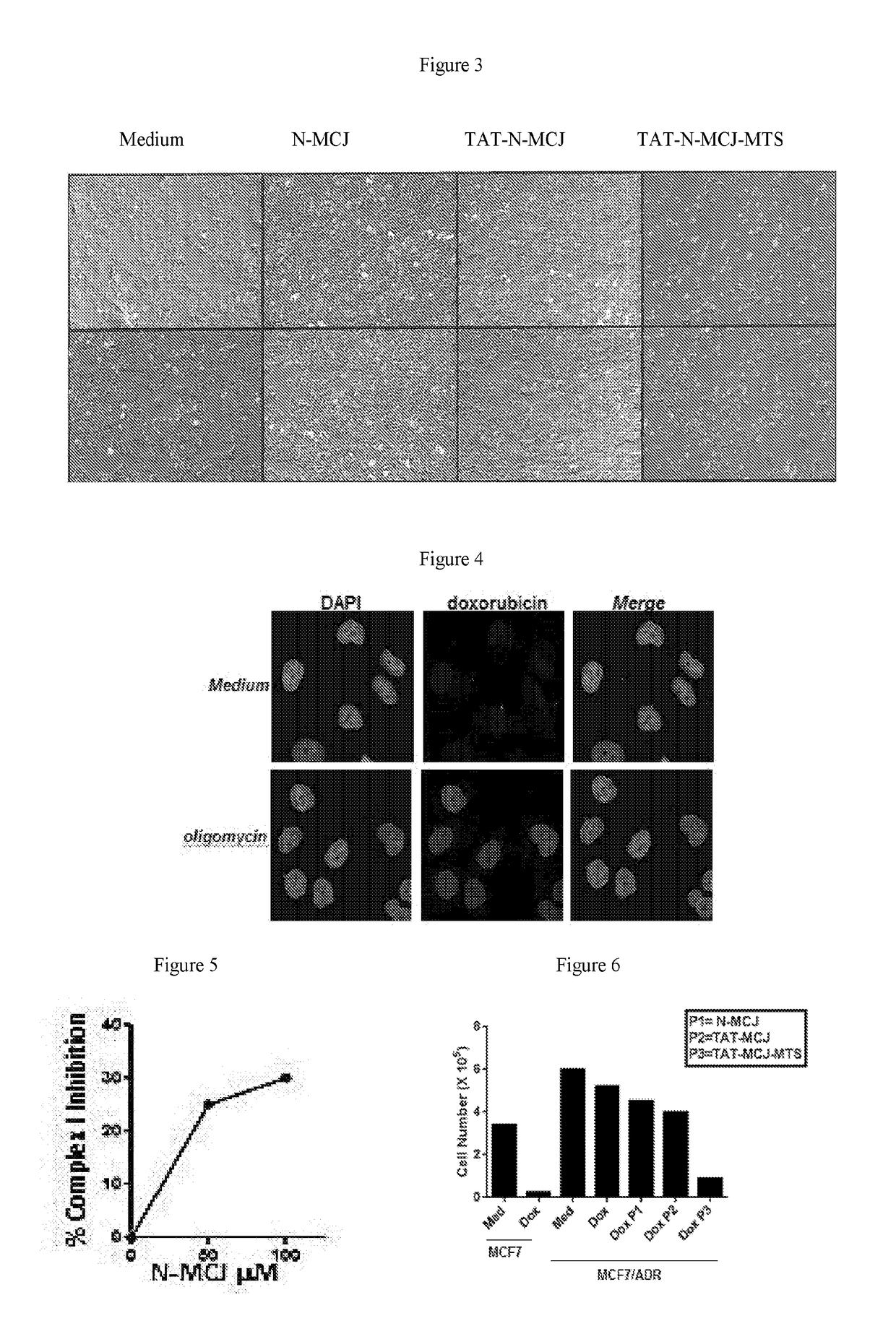Mcj agonists and uses therefor
- Summary
- Abstract
- Description
- Claims
- Application Information
AI Technical Summary
Benefits of technology
Problems solved by technology
Method used
Image
Examples
example 1
ts 1 and 2
[0109]MCJ has been identified as an endogenous negative regulator of mitochondrial respiratory chain and mitochondria-derived ATP production. Cancer cells mostly use glycolysis as a pathway to generate ATP and rapidly grow, instead of using mitochondria-derived ATP. As a result mitochondria have not been considered a major target for cancer treatment because it was believed that inhibition of mitochondria would increase cancer growth.
[0110]A recombinant peptide was generated that contained the N-terminal region of MCJ, a targeting agent, and a mitochondrial-targeting agent. The targeting agent directed the recombinant peptide to penetrate a cancer cell and the mitochondrial-targeting agent directed the recombinant peptide to the mitochondria in the penetrated cell. In this experiment, the targeting agent comprises a TAT-tag, and a mitochondrial targeting signal. The combined recombinant polypeptide acted as an agonist of MCJ function in the mitochondria of the penetrated c...
experiment 1
[0111]MCF7 / ADR cells were incubated (using standard procedures) for three days in media alone or in media plus three different MCJ based polypeptides each at a concentration of 50 μM in media. The cells of set one were incubated in media and served as a control set. The cells of set two were incubated in media that included a 50 μM concentration of a MCJ polypeptide without a targeting agent polypeptide. The amino acid sequence of the N-MCJ polypeptide without a targeting agent polypeptide was MAARGVIAPVGESLRYAEYL (SEQ ID NO:2). The cells of set three were incubated in media that included a 50 μM concentration of a TAT-N-MCJ polypeptide. The amino acid sequence of the TAT-N-MCJ polypeptide was: YGKKRRQRRGMAARGVIAPVGESLRYAEYL (SEQ ID NO:18). The cells of set four were incubated in media that included a 50 μM concentration of a TAT-N-MCJ-MTS polypeptide, which had an amino acid sequence: YGKKRRQRRGMAARGVIAPVGESLRYAEYLGTRTWVPKGLKSP (SEQ ID NO:6). Results are illustrated in FIG. 1, whic...
experiment 2
[0112]MCF7 cells and MCF7 / ADR cells were incubated (using standard procedures) for two days in media alone or in media that included different concentrations of the TAT-N-MCS-MTS polypeptide having the amino acid sequence set forth as:
(SEQ ID NO: 6)YGKKRRQRRGMAARGVIAPVGESLRYAEYLGTRTWVPKGLKSP .
[0113]FIG. 2 shows results of the testing, which showed a significantly greater reduction in the cell number when MCF7 (FIG. 2A) or MCF7 / ADR (FIG. 2B) cells were incubated in media that included a 10 μM or a 50 μM concentration of the TAT-N-MCJ-MTS polypeptide, than when cells were incubated in media alone, or in 1 μM concentration of the TAT-N-MCJ-MTS polypeptide. FIG. 3 shows photomicrographic images of MCF7 / ADR cells that were incubated for two days in (1) media alone; (2) media that included a 50 μM concentration of the N-MCJ polypeptide set forth as SEQ ID NO:2; (3) media that included a 50 μM concentration of the TAT-N-MCJ polypeptide set forth as SEQ ID NO:18; and (4) media that included...
PUM
| Property | Measurement | Unit |
|---|---|---|
| Electrical resistance | aaaaa | aaaaa |
| Sensitivity | aaaaa | aaaaa |
| Chemotherapeutic properties | aaaaa | aaaaa |
Abstract
Description
Claims
Application Information
 Login to View More
Login to View More - R&D
- Intellectual Property
- Life Sciences
- Materials
- Tech Scout
- Unparalleled Data Quality
- Higher Quality Content
- 60% Fewer Hallucinations
Browse by: Latest US Patents, China's latest patents, Technical Efficacy Thesaurus, Application Domain, Technology Topic, Popular Technical Reports.
© 2025 PatSnap. All rights reserved.Legal|Privacy policy|Modern Slavery Act Transparency Statement|Sitemap|About US| Contact US: help@patsnap.com



